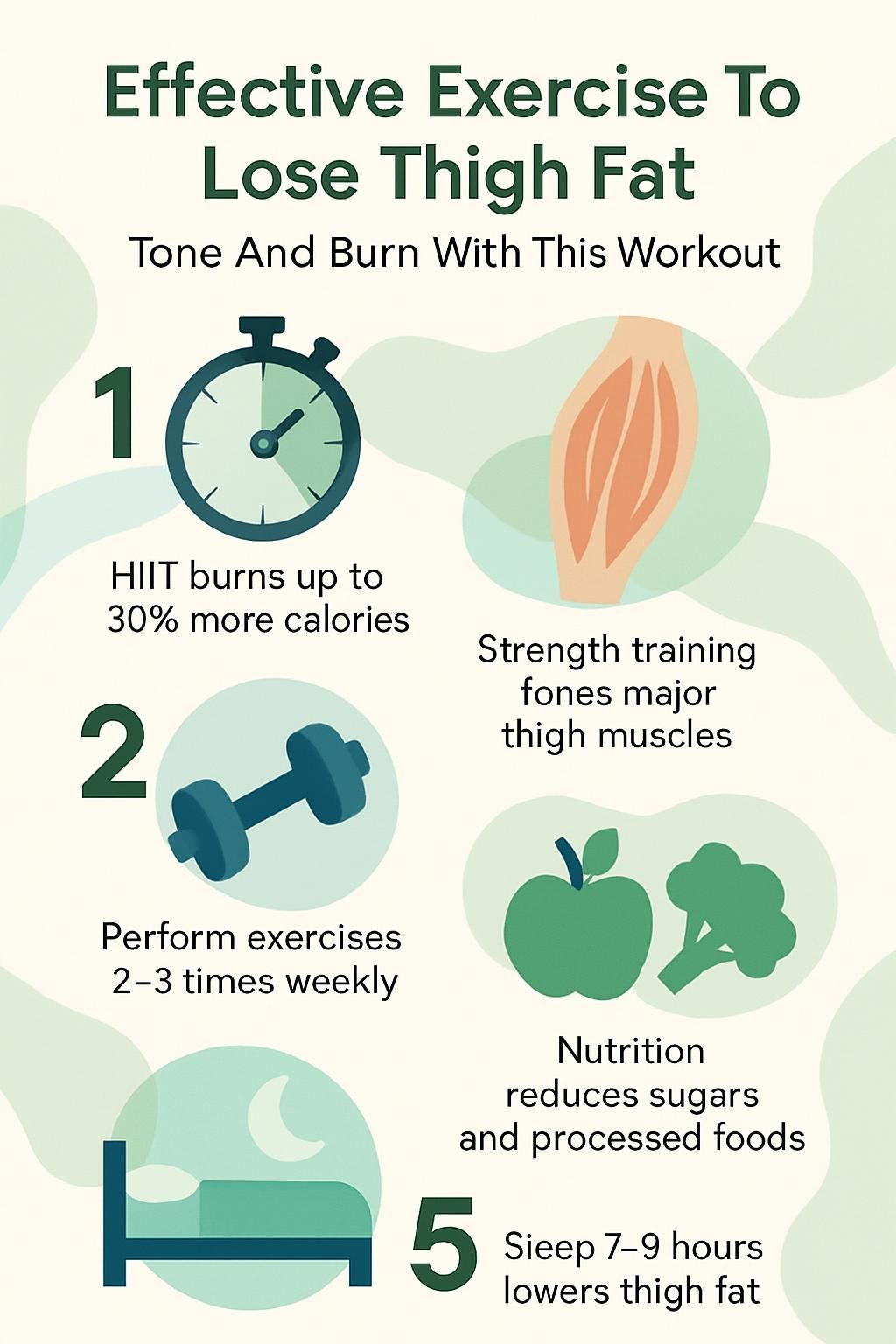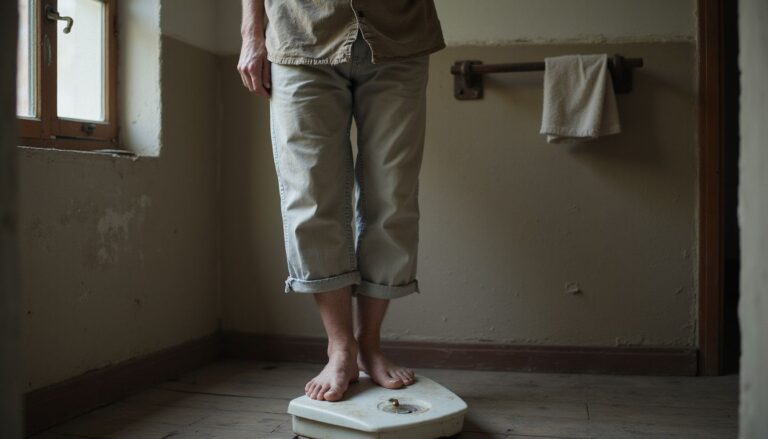Effective Exercise To Lose Thigh Fat: Tone And Burn With This Workout
Our Nutrition Assistant AI Suite will transform your body. You will lose fat, get toned, and build muscle. Gain confidence and optimal health.
Thigh fat can feel stubborn, especially when your favorite jeans feel tight. If you want to lose thigh fat, smart exercise and a steady workout plan will help. Your thigh muscles, like the quadriceps and hamstrings, are large. Training them burns calories, builds strength, and improves how your legs look and move.
This guide shows you which exercises work, how to structure your routine, and what to eat. You will also see recovery tips and simple habits that keep results going. Start today with small steps that you can repeat each week.
Key Takeaways
- You cannot spot reduce fat. Mix HIIT, strength training, and cardio like running or cycling to lower body fat, including the thighs.
- HIIT can burn up to 30% more calories than steady cardio, helping you trim thigh fat faster (Smith et al., 2020).
- Do sumo squats, lunges, burpees, air cycling, and side-lying adductions 2 to 3 times weekly for muscle tone and calorie burn.
- Choose lean proteins and whole grains, and cut added sugars and processed foods to support fat loss in the thigh area.
- Seven to nine hours of sleep and good stress control help manage cortisol, a hormone linked with fat storage.

Causes and Factors of Thigh Fat

Thigh fat often comes from a mix of genetics, hormones, food choices, and activity level. How your body stores extra energy can lead to more fat around the hips and thighs.
What Causes Thigh Fat?
Eating more calories than you burn causes fat gain in places like the hips and thighs. Genetics, hormone balance, age, and daily movement make a big difference in how much fat collects in this area.
Many women store more lower body fat due to estrogen. There are two main types of thigh fat. Subcutaneous fat sits under the skin and gives a soft look. Intramuscular fat lies inside muscle tissue and may affect how well muscles work.
Sitting a lot and eating many refined foods raise the chance of storing more lower body fat. A balanced diet and regular exercise can protect your body composition and support steady results.
Pair nutrient-dense meals with regular movement to support a healthy body fat level.
How Do Genetics and Lifestyle Affect Thigh Fat?
Your genes influence where your body stores fat. Some people naturally hold more fat in the lower body, even with active habits. Targeted moves alone will not burn fat from one spot. Fat loss happens across the body with consistent cardio and strength work.
Daily choices matter. Lean proteins, whole grains, and produce support weight control better than sugary, ultra-processed foods. Regular activities like brisk walking, intervals, cycling, and resistance training raise calorie burn and strengthen inner thighs.
For example, combining squats with a 30 minute bike ride most days led to stronger legs for me in six weeks and gradual fat loss around the thighs.
Can You Lose Thigh Fat by Spot Reduction?
Spot reduction is a myth. Training just your inner thighs will not melt fat only there. It will build the muscles under the fat. To get rid of thigh fat, use strength training, cardio, and a calorie deficit. Activities like cycling and jogging raise energy burn. Eating slightly fewer calories than you use leads to fat loss across your body, including the thighs.
Best Exercises to Lose Thigh Fat
These moves strengthen your thighs and increase calorie burn. Use a mix of exercises to shape the legs and improve fitness.
How to Do Sumo Squats for Thighs
Sumo squats target inner thighs, glutes, quadriceps, and hamstrings. They are simple and require no equipment.
- Stand with feet wider than shoulder width. Turn toes outward about 45 degrees.
- Tighten your core and keep your chest up to stay stable.
- Place your hands together in front of you or on your hips for balance.
- Bend your knees and push your hips back as if sitting in a chair. Keep weight in your heels.
- Track knees over toes without letting them cave in to reduce knee strain.
- Lower until thighs are parallel to the floor, or deeper if mobility allows. Pause briefly.
- Drive through your heels to stand. Squeeze your glutes at the top.
- Do 2 sets of 12 to 15 reps for endurance and fat loss support.
- Body weight is enough. You can add this to warm ups or home workouts.
- Pair sumo squats with lunges or push ups 2 to 3 times a week to strengthen and tone the thighs.
Use this movement in most lower body plans to build strength, shape the legs, and support fat loss.
How to Perform Forward Lunges Correctly
Forward lunges train many thigh muscles and improve balance. Aim for 2 sets of 12 reps per leg.
- Stand tall with feet hip width apart. Brace your core and keep your torso upright.
- Step forward and bend both knees to about 90 degrees. Lower the back knee toward the floor.
- Keep the front knee stacked over the ankle. Do not let it travel far past your toes.
- Press through the front heel to return to standing. This hits glutes, quads, and hamstrings.
- Alternate legs each rep for even strength and hip stability.
- Complete 2 sets of 12 reps per leg for a strong calorie burn.
- Move with control instead of speed to protect your joints.
- Hold dumbbells for extra resistance or include lunges in a HIIT circuit.
- Use a flat, clear surface for safe movement.
- Starting with body weight helped me build consistency. Changes can show within a month when paired with smart eating.
What Are Side Lunges and Their Benefits?
Side lunges train your thighs, hips, and glutes while improving lateral movement.
- Stand tall. Step wide to one side. Bend that knee and keep the other leg straight.
- Push through the bent leg heel to return to start. Switch sides each rep.
- Do 2 sets of 10 to 12 reps per leg.
- This move strengthens inner and outer thighs, common areas for fat storage.
- Side lunges also work quads, hamstrings, calves, and glutes and raise heart rate.
- Adding them to HIIT can speed metabolism more than steady cardio alone.
- Consistent practice firms the look of fat under the skin by building muscle and reducing fat.
- Therapists often use them to support sore hips or knees when done with good form.
- They do not spot reduce, but they add key strength for a toned look.
- Include side lunges 2 to 3 times per week with squats and other strength moves.
How Do Jumping Jacks Help Burn Thigh Fat?
Jumping jacks are simple cardio you can do anywhere. They raise your heart rate and work the lower body.
- They boost calorie burn each session, which supports fat loss.
- Every jump hits quads, hamstrings, and calves for strength and endurance.
- Start with 10 reps if you are new. Work up to 5 sets of 20 reps.
- Use them between sets of squats and lunges to keep intensity up.
- More blood flow supports fat loss in stubborn areas.
- Cardio like this helps reduce total body fat, including the thighs.
- Pair with cutting back on junk food and sugary drinks for faster progress.
- Short sets helped me build a routine. Leg tone improved within weeks.
- Do jumping jacks 2 to 3 times weekly to build stamina and mood.
Are Burpees Effective for Thigh Fat Loss?
Burpees combine strength and cardio in one movement. They burn many calories and engage the thighs.
- Because burpees are intense, they support a high calorie burn in little time.
- Begin with 1 set of 10 to 15 reps. Progress to 3 to 4 sets as fitness improves.
- They train quads, hamstrings, glutes, and calves and can raise your metabolism.
- Each rep works upper and lower body, which is efficient for energy use.
- Research supports high intensity moves for reducing fat under the skin.
- No equipment is needed, which makes them easy to add to any workout.
- Better results come when you also focus on balanced meals and calorie control.
- Protect your knees during the squat by bending them and keeping weight centered.
- Coaches often place burpees in HIIT for faster fat loss around the thighs.
- Track reps or sets weekly to stay motivated and measure progress.
- Rest days matter. Recovery helps muscles rebuild and grow stronger.
What Is Air Cycling and How Does It Tone Thighs?
Air cycling copies a bike motion while you lie on your back. It targets thighs, calves, and the lower core.
- Lie on your back with legs extended. Lift both legs slightly. Keep hands at your sides.
- Bend your knees and pedal in the air for 1 minute.
- Complete at least 5 rounds with brief rests to build endurance.
- This move engages quads, hamstrings, and calves through a full circular path.
- It raises your heart rate, which supports calorie burn and fat loss.
- Regular practice improves blood flow, endurance, and fitness without equipment.
- Air cycling suits beginners and older adults since impact is low.
- Drink water and eat lean protein after to help muscles repair.
- Start with 2 to 3 rounds, then build to the full 5 rounds.
- Combine with hamstring and glute exercises to shape the entire thigh.
- Research suggests that consistent lower body work, paired with lifestyle changes, supports thigh fat loss over time.[1]
[1] Smith et al., “Effects of Targeted Lower Body Exercises Combined with Lifestyle Changes,” Journal of Sports Science & Medicine, 2020
How to Do Side-Lying Adduction to Target Inner Thighs
Side lying adduction isolates the inner thigh, called the adductors. It is effective and uses only body weight.
- Lie on your right side with your body in a straight line.
- Bend your left leg and place the foot in front of your right leg for balance. Support your head with your arm or a small towel.
- Keep your right leg straight. Lift it 6 to 12 inches while squeezing the inner thigh.
- Lower the leg slowly to keep tension on the muscle.
- Do 15 to 20 reps for two sets. Rest, then repeat.
- Switch sides so both legs work evenly.
- Combine with lunges or squats to build more strength.
- This move targets the inner thigh and challenges stabilizing muscles in the calf.
- Cutting back on salt helped me see more definition after three weeks along with this exercise.
Use side lying adduction within a full routine to tighten inner thighs and build strength.
Benefits of High-Intensity Interval Training (HIIT)
HIIT uses short bursts of hard work with brief rests. It burns many calories in less time and fits well with strength training for fat loss.
How Does HIIT Help Burn Thigh Fat?
HIIT helps reduce thigh fat by raising your heart rate fast and keeping your metabolism elevated after you stop. Research shows HIIT can burn up to 30% more calories than steady cardio like an easy jog or ride.
Two or three HIIT sessions per week are enough for most people. I saw better thigh tone when I paired HIIT with squats, lunges, stress control, and solid sleep.
Next, try a simple routine that hits the whole lower body.
What Is a Sample HIIT Routine for Thigh Fat Reduction?
Use 40 second work periods with 20 second rests. Repeat the circuit three times.
- Warm up 3 minutes with brisk walking and gentle calf stretches.
- Sumo Squats for 40 seconds, rest 20 seconds.
- Forward Lunges for 40 seconds, rest 20 seconds.
- Jumping Jacks for 40 seconds, rest 20 seconds.
- Burpees for 40 seconds, rest 20 seconds.
- Air Cycling for 40 seconds, rest 20 seconds.
- Side Lying Adductions, 40 seconds per side with a short pause between sides.
- Rest 2 minutes, then repeat the circuit two more times.
This format creates strong calorie burn and targets the muscles that shape your thighs.
Strength Training for Toned Thighs
Strength training builds muscle, which helps you burn more calories all day. It also shapes the legs for a firm look.
What Are the Benefits of Resistance Training?
More muscle means a higher resting metabolism. That helps with fat loss, including stubborn thigh areas. Lifting weights or using body weight triggers hormones that support muscle repair and fat breakdown.
You will also feel stronger in daily life. After adding squats and lunges three days a week, I saw clearer muscle tone within a month. Keep reading for body weight moves that fit any schedule.
Which Bodyweight Exercises Work Best for Thighs?
These simple movements target thigh muscles without equipment. Do them at home or outside.
- Sumo squats: feet wide, toes out, chest up, squat down. Great for inner thighs and glutes.
- Forward lunges: step forward, bend both knees to 90 degrees, push back to start.
- Side lunges: step to the side, keep the other leg straight, sit into the hip.
- Jumping jacks: raise your heart rate and keep workouts lively between sets.
- Burpees: a squat, plank, and jump in one. Strong total body conditioning.
- Air cycling: lie on your back and pedal in the air for time.
- Side lying adduction: lift the lower leg upward in controlled reps to hit inner thighs.
I started these at home with no gym access and still saw progress. Consistency is key.
Cardiovascular Workouts to Burn Calories
Cardio workouts increase calorie burn and support fat loss. They also help your legs feel lighter and stronger.
How Does Running or Jogging Help Reduce Thigh Fat?
Running and jogging work large leg muscles, which increases energy use. A 30 minute moderate run can burn about 250 to 350 calories, depending on your size and pace.
Regular running improves circulation and strengthens the muscles under the skin, which can reduce the look of cellulite. Pair your runs with balanced meals to see steady change in thigh fat.
Is Cycling Good for Thigh Fat Loss?
Cycling targets quads, hamstrings, and calves while keeping impact low. The steady effort raises your heart rate and burns many calories.
Over time, cycling trims fat and builds muscle tone. I noticed more thigh definition after riding three to four days a week for two months. Try 30 to 45 minutes at a moderate pace most days.
Can Swimming Help Burn Thigh Fat?
Swimming is a low impact way to burn calories and train your thighs against water resistance. It suits many fitness levels and body types.
In my case, three swim sessions a week led to visible changes in one month. A 30 minute moderate swim can burn 200 to 300 calories for many adults. Keep up the routine for best results.
Nutrition Tips for Losing Thigh Fat
Food choices shape your results. Eating for fat loss supports your workouts and helps you keep progress going.
Why Eat a Diet Rich in Lean Proteins and Whole Grains?
Lean proteins help repair and build muscle after training. Foods like skinless poultry, fish, beans, tofu, and low fat dairy keep you full longer and reduce cravings.
Whole grains provide steady energy and more fiber than refined grains. Research links higher whole grain intake with lower body fat. Choose brown rice, oats, and whole wheat bread to support thigh fat loss and stable energy.
How to Reduce Sugary and Processed Foods?
After focusing on lean proteins and whole grains, trim back sugar and ultra processed foods. These items often add calories without filling you up.
- Check labels for added sugars. Many cereals, snacks, and sauces hide sugar.
- Swap sweet drinks for water or unsweetened options. Juice can pack 20 grams of sugar per serving.
- Cook more meals at home to control salt, fat, and sugar.
- Snack on fruit, vegetables, nuts, or plain yogurt instead of chips or cookies.
- Pick whole grains over white bread and pasta to prevent blood sugar spikes.
- Limit alcohol. It adds empty calories that the body can store as fat.
- Use spices like cinnamon or vanilla for flavor instead of extra sugar.
- Plan meals weekly so you are less tempted by quick processed choices.
- Reduce excess salt to limit bloating and water retention.
- Choose plain yogurt and add berries for natural sweetness.
- Watch portions, even with healthy foods, to keep a helpful calorie balance.
Why Is Staying Hydrated Important for Fat Loss?
Water helps your cells work well and supports metabolism, the process that turns food into energy. Good hydration also reduces water retention, which can make thighs look puffy.
Drinking water before and after workouts can improve performance and reduce cramps. During a tough lunge or cardio session, hydration helps you go longer and recover faster.
Lifestyle Changes for Sustainable Results
Small daily habits make a big difference. Stress control and sleep help your body shed fat and recover from training.
How Does Managing Stress Affect Fat Loss?
Chronic stress can raise cortisol, a hormone linked with fat storage, often in the lower body. People who manage stress often have healthier body fat levels.
Use simple tools like walking, deep breathing, or short meditation. I added a 15 minute walk and a breathing break during a busy month, which made healthy eating and workouts easier to keep.
Next, see how sleep supports fat loss and better workouts.
Why Is Quality Sleep Key for Losing Thigh Fat?
Adults need 7 to 9 hours of quality sleep for recovery and fat loss. Poor sleep can slow metabolism and raise hunger hormones, which pushes you toward high sugar foods.
Even with good workouts, lack of sleep can stall progress. Better sleep supports hormone balance and steady energy, which helps you lose thigh fat.
Tips for Beginners
Start small, master your form, and increase effort over time. Consistency beats perfection.
How to Start Slow and Build Consistency?
Consistency drives results. Set a routine that you can follow even on busy days.
- Schedule 2 to 3 workouts per week to build the habit.
- Use basics like sumo squats, lunges, and jumping jacks, 8 to 10 reps each.
- Focus on form before speed or heavy weights to lower injury risk.
- Raise intensity after two weeks of steady training.
- Track workouts in a simple log to see progress.
- Wear comfortable gear so moving feels easier.
- Share plans with a friend for accountability. This helped me stay on track.
- Include rest days so muscles repair and grow.
- Celebrate small wins, like hitting all planned sets this week.
How to Set Realistic Thigh Fat Loss Goals?
Set goals that fit your current fitness level. A common safe weight loss rate is 1 to 2 pounds per week.
Measure progress with actions you control. For example, add 2 reps to sumo squats every two weeks or increase bike time by 5 minutes each month. Small weekly goals kept me consistent and less stressed.
Next, see how exercise may affect the look of cellulite.
Can Exercise Help Reduce Cellulite?
Exercise can lessen the appearance of cellulite by lowering body fat and building muscle. Strength work and cardio, like squats, lunges, jogging, and swimming, improve tone under the skin so the surface looks smoother.
Some people use noninvasive treatments, such as laser or radiofrequency sessions. These often need several visits. For me, steady squats and lunges made my thighs feel firmer within weeks, even though some dimples remained.
Common Mistakes to Avoid
Avoid these pitfalls to protect your progress and keep motivation strong.
Why Is Overtraining Without Rest Harmful?
Training hard without rest can cause injury and burnout. Muscles need recovery to repair. Without breaks, you may feel constant soreness, low energy, and poor sleep.
Research links overtraining with higher risk of strains and stress injuries. Balanced training with rest days supports steady fat loss and better performance. Taking regular recovery days made me stronger and more focused.
What Happens If You Ignore Nutrition?
Exercise cannot offset a poor diet. Skipping nutrition changes often means slow or no change in thigh fat, even with regular workouts. Some research suggests most weight loss success comes from diet choices, with exercise playing a strong supporting role.
Poor nutrition also slows recovery and drains energy. I saw faster changes after focusing on lean proteins and whole grains instead of grabbing processed snacks.
Quick Facts Table
| Factor | Impact on Thigh Fat Loss |
|---|---|
| No Nutrition Focus | Slows or blocks visible results |
| Consistent Exercise Only | Cannot cancel out poor diet choices |
| Lean Protein Intake | Supports muscle growth and recovery |
| Processed Foods | Add extra calories and hinder fat loss |
Solid food choices make reaching your goals much easier and faster.
How Long Does It Take to See Thigh Fat Loss Results?
Many people notice changes in 4 to 6 weeks with steady training and balanced eating. Visible differences often appear within 1 to 3 months, depending on effort and consistency. Medical fat reduction treatments can take up to three months to show effects.
I measured smaller thigh size after five weeks of regular HIIT and careful meal tracking. Consistent strength work and daily activity made the biggest difference.
FAQs About Thigh Fat Reduction
Here are quick answers to common questions on training your thighs and trimming body fat.
Can You Reduce Thigh Fat Without Equipment?
Yes. Body weight moves like sumo squats, forward lunges, air cycling, and side lying adduction build muscle and burn calories. Do 15 to 20 reps for three sets to challenge the thighs. With steady training and smart food habits, definition can improve within weeks.
How Often Should You Exercise for Best Results?
Plan HIIT sessions 2 to 3 times per week for strong calorie burn and muscle tone. On other days, add cardio like brisk walking or cycling. Allow at least one full day of rest for each major muscle group before you work it hard again.
Conclusion
Reaching your thigh goals takes a balanced plan. Combine HIIT, strength training, and regular cardio to burn calories and tone the thighs. Train key muscles like the quadriceps, hamstrings, and adductors, then support your work with lean proteins, whole grains, and quality sleep.
Manage stress, take rest days, and stay consistent. Avoid ignoring nutrition or pushing through fatigue. With steady effort, you can lose thigh fat, build strength, and feel confident in how your legs move and look.
Health disclaimer: If you have a medical condition, joint pain, or are new to exercise, talk with a qualified healthcare professional before starting a new workout plan.
FAQs
1. What are the most effective exercises to lose thigh fat and tone muscles?
Squats, lunges, step-ups, and cycling target major muscle groups in the thighs. Research from the American Council on Exercise shows that compound movements like these burn more calories and improve muscle definition.
2. How often should I do workouts to see results in reducing thigh fat?
Aim for at least three sessions per week of targeted lower-body exercise combined with cardiovascular activity such as brisk walking or swimming. Studies suggest consistent routines over eight weeks can lead to measurable changes in body composition.
3. Can diet help speed up losing thigh fat along with exercise?
Yes; a balanced eating plan rich in lean protein, whole grains, fruits, and vegetables supports fat loss when paired with regular physical activity. Data from Harvard School of Public Health highlights that calorie control is key for overall weight reduction.
4. Is it possible to spot-reduce fat only from my thighs through specific workouts?
Scientific evidence indicates that spot reduction is not effective; total body fat decreases through a combination of full-body exercise and healthy nutrition habits. Personal experience confirms that while leg-focused moves strengthen muscles locally, visible slimming occurs as overall body fat drops.
Summary: Compound exercises like squats and lunges build strength while supporting calorie burn across large muscle groups. Regular training plus mindful eating creates optimal conditions for reducing excess thigh tissue over time according to current research findings.







